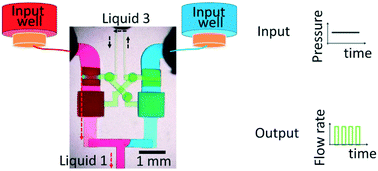Water-head-driven microfluidic oscillators for autonomous control of periodic flows and generation of aqueous two-phase system droplets†
Abstract
Generating periodic flows with an oscillator driven only by water-head pressure has potential for the operation of microfluidic systems without any dynamic off-chip controllers. However, its operational characteristic is not well understood due to complex dynamic interactions of the microfluidic components. Here, we focus on the mechanism of a water-head-driven oscillator and analyze the functions of its flow-switching period (T) and flow rate (Q) in a wide range (0.1 s–5.9 h and 2 μL min−1–2 mL min−1). We show linear control of T and Q by their corresponding fluidic resistors even with the complex and nonlinear relation of the microfluidic components. This allows independent regulation of T and Q within their operational ranges but we found the two parameters mutually constrain their ranges via fluidic resistance. Also, we characterize the control of T by water-head pressure and present operational ranges of input water-head pressure decrease with increasing output water-head pressure. To show its utility, we apply the oscillator to generate droplets with low interfacial tension aqueous two-phase systems. Our study would be useful and provide the foundation for various functions of water-head-driven microfluidic circuits.



 Please wait while we load your content...
Please wait while we load your content...